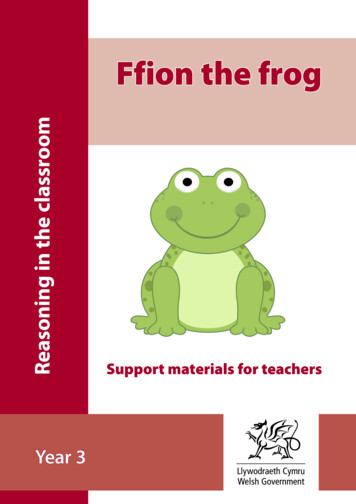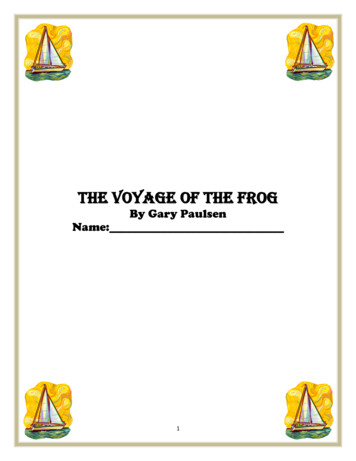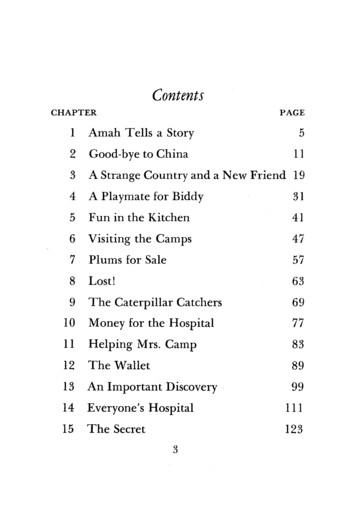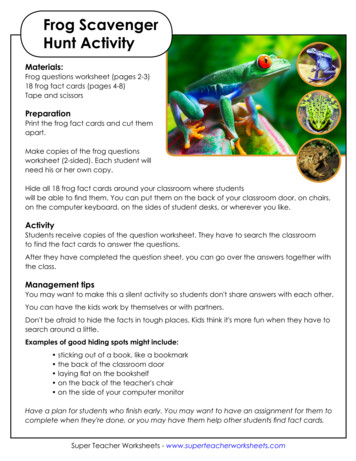
Transcription
Reasoning in the classroomFfion the frogYear 3Support materials for teachers
Year 3 Reasoning in the classroom – Ffion the frogThese Year 3 activities start with an item that was included in the 2014 NationalNumeracy Tests (Reasoning). They continue with three linked activities, requiringlearners to use their numeracy skills to solve problems within a range ofdifferent contexts.Ffion the frogLearners find different ways for a frog to jump to 10.Then they consider how many spiders the frogs eat.Includes: Teachers’ script PowerPoint presentation Ffion the frog questions MarkschemeFrogsThey use their knowledge of times tables to play a game, choosing numbers that givetheir ‘frog’ an advantage over other groups.Includes: Explain and question – instructions for teachers Teachers’ sheet – Number cardsPerfect webLearners explore the shapes made within a spider’s web, then create their own.Includes: Explain and question – instructions for teachers Whiteboard – Spider’s web Whiteboard – Perfect webZigzag leapsThey find the quickest route for their frog to reach safety.Includes: Explain and question – instructions for teachers Whiteboard – Zigzag Resource sheet – ZigzagYear 3 Reasoning in the classroom: Ffion the frogIntroduction
Reasoning skills requiredIdentifyCommunicateReviewLearners use their numericalskills within a variety of contexts.They explain their approach andalso their findings.They consider their results andhow they can be changed tomatch different scenarios.Procedural skillsNumerical language Simple combinations Same/different Addition and subtraction More than Multiplication tables (2, 3, 4, 5) Altogether Shape names and simple properties Multiple (if appropriate) Simple geometric construction, using dotty Digitpaper Number patterns Use of letters and numbers to identifysquares on a grid Even/odd Triangle, square, rectangle, trapezium,hexagon, rhombus (diamond) Right angle FewestYear 3 Reasoning in the classroom: Ffion the frogIntroduction
Ffion the frog
Activity 1 – Ffion the frogorOutlineThis Year 3 activity is based around three numerate frogs. Learners watch ananimation that shows a frog jumping, and use simple combinations to work outonto which lily pads different frogs can jump. Then they solve a problem to findthe number of spiders eaten by each of the three frogs.You will needTSTeachers’ scriptPowerPoint presentationQFfion the frog questionsThree pages for each learner, can be printed double-sidedMMarkschemeYear 3 Reasoning in the classroom: Ffion the frogActivity 1 – Ffion the frog – Outline
TSPresentation to be shown to learners before they work on Ffion the frogSlide 1Reasoning in the classroomThe text in the right-hand boxes (but not italics) should be read to learners. You can use yourown words, or provide additional explanation of contexts, if necessary. However, if you are usingthis as an assessment item, no help must be given with the numeracy that is to be assessed.Ffion the frogSlide 2(Keep this slide on the screen until you are ready tostart the presentation.)This is Ffion the frog.She is very good at jumping!Year 3 Reasoning in the classroom: Ffion the frogActivity 1 – Ffion the frog – Script
TSSlide 3withanimation(From this point on, do not use the arrow keys on thecomputer, but navigate using the arrow buttons thatappear on the screen.)Ffion starts here (point to her) and jumps forward.Watch her jump forward (Click on the large arrow button to the left of thescreen, and she will jump to 3. Then click on it againand she will jump to 7. Click again and she will jumpto 10)So, when she started, Ffion jumped forward 3to land on lily pad number 3. Then she jumpedforward 4 (count out loud) to land on number 7.How much did she jump forward then? That’sright, she jumped forward 3 to land on 10(Now click on the arrow button again, and the textbeneath the lily pads appears. Read it out loud, andthen click on the arrow button again. An option toreplay is given; unless necessary, ignore and click thebutton to move to the next scene.)Slide 3animationcontinuedThis time we can see that Ffion is going to jumpforward 1, then 5, then 4 (point to the relevant text).Which lily pads will she land on?(Discuss and agree together that she will land on 1,then 6, then 10Now show the jumps by clicking to show eachstage of the animation, saying out loud what ishappening.Then click on the arrow button again. An option toreplay is given; again, unless necessary, ignore andmove to the next screen.)Year 3 Reasoning in the classroom: Ffion the frogActivity 1 – Ffion the frog – Script
TSSlide 3animationcontinuedNow Ffion is going to jump forward 2, 2 and 6 –but she can jump them in any order.There are 3 ways she can do this. Can you tell meabout all 3?(Encourage learners to discuss among themselves,and then ask for solutions, but do not discussmethods used.)Well done! You have found all 3 different ways.Let’s watch her (Repeated clicking reveals all 3 possible outcomes. Asthe frog moves, describe the move out loud, e.g. shejumps 6)Now you are going to answer some questionsabout Ffion and how she jumps forward.Remember to show your working so thatsomeone else can understand what you are doingand why.(If you are using this item for assessment purposes,you may wish to limit the time available, e.g.15 minutes.)Year 3 Reasoning in the classroom: Ffion the frogActivity 1 – Ffion the frog – Script
Q12, 3, 5Ffion jumps forward 2, 3 and 5, in any order.Show all the different ways she can do this.One is done for you.Start123456789 10Start123456789 10Start123456789 10Start123456789 10Start123456789 10Start123456789 10Ffion the frog4mActivity 1 – Ffion the frog – Questions
Q2Fred jumps forward 3 and 7, in any order.How many different ways can he jump to 10?1m3Flo jumps to 10 using jumps of the same size.Show different ways she can do this.Start123456789 101mStart123456789 101mFfion the frogActivity 1 – Ffion the frog – Questions
Q4Flo, Fred and Ffion eat spiders.I eat2 morethan Flo.FloFredI eat2 morethan Fred.Ff ionFlo, Fred and Ffion eat 30 spiders altogether.How many spiders does each one eat?Flo eatsspiders.Fred eatsspiders.Ffion eatsspiders.3mActivity 1 – Ffion the frog – Questions
MActivity 1 – Ffion the frog – MarkschemeQMarks14m2AnswerShows all five remaining ways, in any order,i.e.12234567789 101012334556789 101012334567889 101012345567789 101012345567889 1010Or 3mGives any four different waysOr 2mGives any three different waysOr 1mGives any two different ways1m2OrShows 7 and 3 in that order32m7As 3 and 7 is given in the question,7 and 3 is condoned as 2 waysare then identified, even if notexplicitlyAny two of the rows below1234556789 1010123445667889 10101011 22 33 44 55 66 77 88 99 10Or 1mAny one of the rows aboveYear 3 Reasoning in the classroom: Ffion the frogActivity 1 – Ffion the frog – Markscheme
MActivity 1 – Ffion the frog – Markscheme (continued)QMarks43mAnswerAll three correct, and in the right order, i.e.81012Or 2mGives 8, 10 and 12 but in an incorrect orderOrGives 10, 12, 14 or 6, 8, 107Has recognised the significance of10 and the difference of 2, but hasforgotten that the total is 30OrGives three values, all greater than 0, thattotal 30 and the second value is 2 more thanthe first, or the third value is 2 more than thesecond, e.g. Or 1m681641214 2 2Gives three values, all greater than 0, thattotal 30OrGives three values, all greater than 0, and thesecond value is 2 more than the first, and thethird value is 2 more than the second, e.g. 246 2 2Year 3 Reasoning in the classroom: Ffion the frogActivity 1 – Ffion the frog – Markscheme
MActivity 1 – Ffion the frog – ExemplarsQuestion 1123456789 10 123456789 10 123456789 10 123456789 10 123456789 10 123456789 10 123456789 10 123456789 10 All five correct; 4 marks Four correct; 3 marks 123456789 10rpt123456789 10 123456789 10 123456789 10 123456789 10 23456789 10rpt123456789 10rpt3, 5, 10 is repeated: 2, 7, 10 is omitted.Two correct; 1 mark 1This learner has a clear and effective system for generating theoutcomes.2, 8, 10 is incorrect.5, 7, 10 is repeated and 2, 5, 10 is a repeat of the way shownwithin the question.Question 2Shows 7 and 3; 1 mark3 7 and7 3 Both ways are shown.Incomplete; 0 marks3 and 7 This learner has repeated the information given but has notidentified the other way, 7 and 3Question 3123456789 10123456789 10One correct row; 1 mark Year 3 Reasoning in the classroom: Ffion the frogThe use of crosses is unambiguous. The first row is correct but asthe second row includes 1 it is incorrect.Activity 1 – Ffion the frog – Exemplars
MActivity 1 – Ffion the frog – Exemplars (continued)Question 430 3 1010, 10, 109, 10, 118, 10 12Flo eatsFred eatsFfion eats10 2 12 2 14Flo eatsFred eatsFfion eatsFlo eatsFred eatsFfion eatsFlo eatsFred eatsFfion eatsFlo eatsFred eatsFfion eatsFlo eatsFred eatsFfion eatsFlo eatsFred eatsFfion .Correct; 3 marksspiders. This learner shows a clear and effective method.spiders.spiders.spiders.10, 12, 14; 2 marksspiders.spiders.spiders.Total 30; 1 markCommonerrorspiders.This learner shows some understanding but does notengage with ‘2 more’.spiders.spiders.Total 30; 1 markspiders.spiders.spiders.Two differences of 2; 1 s.spiders.Year 3 Reasoning in the classroom: Ffion the frogTwo differences of 2; 1 markCommonerrorThis learner has ignored the word ‘altogether’.Incorrect; 0 marks The total is not 30 and only one difference of 2 is shown, so nocredit can be given.Activity 1 – Ffion the frog – Exemplars
Frogs
Activity 2 – FrogsorOutlineThis Year 3 activity continues the theme of frogs presented inActivity 1 – Ffion the frog.Each group chooses one person to be their ‘frog’, then uses their knowledgeof multiplication tables to decide whether their frog can move. Finally, theychoose numbers that will allow their frog (but not the frogs of other groups)to move.You will needA large space, e.g. playground or hallChalk or masking tapeTYear 3 Reasoning in the classroom: Ffion the frogTeachers’ sheet – Number cardsActivity 2 – Frogs – Outline
Activity 2 – FrogsMark a starting line in the playground, or other large space. Then ask each group to selecta number at random from Number cards, and choose one of their group to be their first‘frog’. (Emphasise that each learner will have a turn.)ExplainThe frogs from each group stand on the line, with you standing an appropriate distanceaway. Tell learners they are going to race and the winning group will be the one whose frogreaches the finishing line (you) first. Call out a whole number that is 40 or less. Frogs canmove if the number called is in the times table for the number on their card (learners mayneed support to realise that times tables continue beyond 10 or 12 ). The group discussesthen, if it is, tells their frog to move one toe-to-heel step towards you.Repeat the game, but this time each group takes it in turn to call out a number of theirchoice. Each number can only be called once (record as you go, to avoid dispute). Givelearners time to decide what numbers to call.Once a winner is found, discuss, using the questions below as a guide. Then repeat, toallow them the chance of improving their performance through the choice of numbersthey call. (Replace number 2 cards with different numbers – see questions below.)Repeat until each learner has had the opportunity to be a frog. At the end, discuss, againusing the questions as a guide. What is the best number card to have? (Number 2, as the frog can then move every timean even number is called. Note: at the end of the first game, take the number 2 cards awayand replace them with different numbers.)Question If groups with number 4 move, who else must be able to move? Why? (Groups withnumber 2 as the numbers must be even) How did you decide which number to call? Do you think you made the right choices?Why/why not?At the end of the game If you could have chosen any card other than number 2, which one would it be? Why?(The smaller the number, the more multiples there are in the numbers from 1 to 40.) What type of numbers could you have called to make sure groups with 2 or 4 could notmove? (Odd numbers) What were the best numbers for your group to call? Why? (If possible, a multiple thatexcludes other groups’ numbers, e.g. for the group with number 5, 25 as that is not amultiple of any of the other numbers)Extension What would happen if the number 60 was called out? (Every frog would move.) Can youfind another number that allows every frog to move at the same time? (120 or any othermultiple of 60)Year 3 Reasoning in the classroom: Ffion the frogActivity 2 – Frogs – Explain and question
TOne card for each group.If appropriate, numbers can be changed to allow for other multiplication tables (e.g. include number 6).2 3 4 52 3 4 5Ffion the frogActivity 2 – Number cards – Teachers’ sheet
Perfect web
Activity 3 – Perfect weborOutlineThis Year 3 activity connects loosely with the theme of frogs eatingspiders from Activity 1 – Ffion the frog.Learners explore the shapes within a real spider’s web, then draw theirown ‘perfect’ web, using as much geometric precision as they can, andagain considering different shapes within their web. They also investigatea number pattern.You will needWBWhiteboard – Spider’s webWBWhiteboard – Perfect web2cm triangular dotty paper/isometric paper(freely available online, e.g. at http://lrt.ednet.ns.ca/PD/BLMEss11/pdf files/dot paper/iso dot 2cm.pdf )RulersSharp pencilsYear 3 Reasoning in the classroom: Ffion the frogActivity 3 – Perfect web – Outline
Activity 3 – Perfect webExplainRemind learners that in Activity 1 – Ffion the frog the frogs ate spiders. But what dospiders eat? (Spiders are also carnivores, e.g. they eat flies.) Show Spider’s web on thewhiteboard, and if appropriate, explain how the spider creates its web to catch its prey.(There are many websites that provide information, e.g. web-between-two-trees)Ask learners to look at the shapes within the spider’s web. Point to one of the four-sidedshapes that is clearly not a rectangle and ask why the shape is not a rectangle. (Rectangleson thehave two pairs of parallel sides and four right angles.) Draw a trapeziumwhiteboard to show the difference between a rectangle which has four right angles anda trapezium which doesn’t. (Be careful not to imply that a trapezium has no right angles as it)can have two, e.g.Explain that as a spider doesn’t have a ruler, the shapes in its web are not ‘perfect’. Telllearners they are going to make a ‘perfect’ web and show Perfect web on the whiteboard.Give each learner a sheet of 2cm triangular-dotty paper, a ruler and pencil. Ask them toput a dot to show the centre of their web, then encourage discussion on how to continue.Once they have drawn their webs, ask them in their pairs/groups to explore what shapesthey can see and colour in shapes if appropriate. Discuss, helping learners to see (andname) different sizes of hexagons, (equilateral) triangles, trapeziums and rhombuses(diamonds).Finally, draw attention to the number of dots that can be seen on each ‘ring’. The first ringhas 6 dots. How many rings does the second ring have? (12) What about the third ring?(18) How many dots do learners think would be on the fourth ring, and why? (24, becausethe number of dots increases by 6 each time a ring is added) What shapes can you see in the real spider’s web? Can you see another . . . ? Andanother? Why do you think the spider doesn’t spin its web (the threads) with perfectly straightQuestionlines? (It doesn’t need to and there needs to be flexibility.) How can you start drawing your web? (Join the dots to each other and to the centre.) Howcan you make sure your lines are ‘perfect’? (Use a ruler.) How can you make sure the rings of your web are ‘perfect’? (Count the number of dotsalong the radial lines.) What shapes can you see in your web? How many . . . can you see? What else? How many dots would be in the fifth ring . . . or the sixth . . . or . . . ? How are youworking out the answers? Which ring has 60 dots? How do you know? (Learners can use their knowledge of the10-times table as 10 6 60 it must be the tenth ring.)Year 3 Reasoning in the classroom: Ffion the frogActivity 3 – Perfect web – Explain and question
WBFfion the frogActivity 3 – Spider’s web – Whiteboard
WBFfion the frogActivity 3 – Perfect web – Whiteboard
Zigzag leaps
Activity 4 – Zigzag leapsorpondOutlineThis Year 3 activity continues the context of frogs leaping as introduced inActivity 1 – Ffion the frog.In the real world, frogs leap in a zigzag pattern in order to confuse predators.Learners use this way of moving to help the frog reach the safety of a pond.As this activity requires reuse of the resource sheet, it may be helpful for anadult to work with a small group of learners at one time.You will needWBRYear 3 Reasoning in the classroom: Ffion the frogWhiteboard – ZigzagResource sheet – ZigzagOne for each pair, laminated if possibleActivity 4 – Zigzag leaps – Outline
Activity 4 – Zigzag leapsRemind learners of the way Ffion the frog leaps across the lily pads in Activity 1 – Ffionthe frog. Explain that in the real world, when frogs are frightened, it is unusual for themto leap in a straight line; instead they zigzag in order to confuse predators. They cannotjump backwards.ExplainTell learners they are going to play a game to see how quickly their frog can zigzag acrossthe land to the safety of the pond. Show Zigzag on the whiteboard and explain that thisis the land the frog needs to cross. Show how each square can be identified using a letterfollowed by a number, and check understanding.The frog must jump one square at a time, so where can the frog go on its first jump?(A2, B1 or B2) Choose one of these squares, then draw a line from the frog to that square.Now say that the frog must change direction. Where can it jump to now? (For example, ifit jumped from A1 to B2, it cannot jump to C3 as that continues the previous direction. And itcannot go back to A1 as this would entail jumping directly backwards, which it cannot do.)Continue the frog’s jumps until it reaches safety on square F6.6Now give each pair/group a laminated copy of Zigzag. Ask themto create a different route for the frog to jump from A1 to thepond. Then ask learners to count how many jumps their frog hasmade, and compare across the class. Explore which is the quickestroute (there are several) and the minimum number of jumpsneeded (seven), e.g.54321ABCDEFNow introduce the rule that the frog can jump up to two squares in the same directionat any one time – now what is the minimum number of jumps needed? (Four, e.g. C3, E3,E5, F6) Once the class has compared their solutions, ask them to find a route that takesexactly five jumps, or six, or . . . In real life, why is it harder for a bird to catch a frog if it is zigzagging rather thanjumping in straight lines? (The bird can’t predict where the frog is going next, and it mightfind it harder to change direction as quickly as the frog.)Question Why do we use letters and numbers on the grid? (So that each square is unique) (When the frog is only jumping one square at a time) If your frog is in the middle of thegrid, how many squares can it jump to next? (There are eight adjacent squares, but oneentails the frog jumping directly backwards, and one is in the same direction as it has comefrom, so six.) If your frog jumps from this square (point) to this one (any two jumps that create a rightangle, e.g. D4 to E4 to E5) what turn has it made? (A quarter-turn) Do you know anothername for that? (Right angle) How can you quickly change a route that has four jumps to one that has five jumps?(Replace a diagonal with a horizontal line and a vertical line.)Year 3 Reasoning in the classroom: Ffion the frogActivity 4 – Zigzag leaps – Explain and question
WBpond654321AFfion the frogBCDEFActivity 4 – Zigzag – Whiteboard
Rpond654321AFfion the frogBCDEFActivity 4 – Zigzag – Resource sheet
Learners find different ways for a frog to jump to 10. Then they consider how many spiders the frogs eat. Includes: Teachers’ script PowerPoint presentation Ffion the frog questions Markscheme Frogs They use their knowledge of times tables to play a game, choosing numbers that give thei











